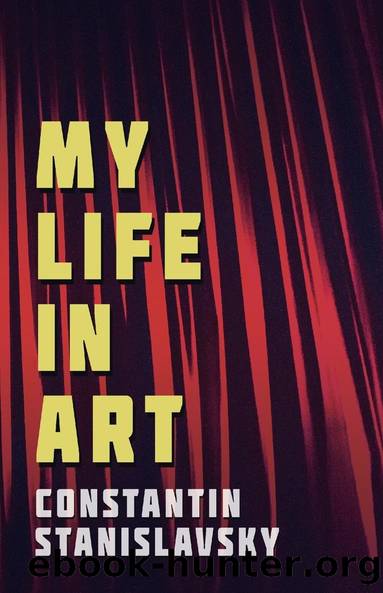My Life In Art - Translated from the Russian by J. J. Robbins - With Illustrations by Constantin Stanislavsky

Author:Constantin Stanislavsky [Stanislavsky, Constantin]
Language: eng
Format: epub
ISBN: 9781528705837
Barnesnoble:
Publisher: Read Books
Published: 2018-08-10T00:00:00+00:00
In the year when Nemirovich had redoubled his quest in the Philharmonic School there was preparing an extraordinary class of graduating pupils. A complete company that seemed to have been handpicked was being graduated. All of them were more or less fit for the stage, and several had extraordinarily artistic individualities. How could one let such a company, which seemed to be picked by Destiny itself, go? Was it possible to let them disperse to all sides, to the far corners of the provinces? How was one not to make use of them for the creation of the long-awaited theatre!
And at last we met! During the winter we made the closer acquaintance of each other and of the future actors of our company. Nemirovich visited all the performances of our Society and after each one spoke with me and criticized them with complete sincerity. It can be said in our favor that at that time we were not afraid to hear the truth. He spoke in turn to every actor, put questions to them that were necessary for him for the explanation of the individual nature of each actor. On my side, I was a constant attendant at all the performances of the Philharmonic Society, and in my way did the same thing with his pupils.
In May or in June, 1897, I received a note from Nemirovich-Danchenko, inviting me to a conference in the restaurant âThe Slavic Bazaar.â We met, and he explained to me the purposes of our meeting. They lay in the foundation of a new theatre, which I was to enter with my group of amateurs, and he with his group of pupils. To this nucleus we were to add chosen professional actors from Petersburg, Moscow, and the provinces. The most important questions before us were these: how far the artistic principles of the chief controllers of the new theatre agreed with each other, what compromises each of them was willing to make, and were there any points in common between us.
The peace conference of Versailles did not consider the world questions before it with such clarity and exactness as we considered the foundations of our future enterprise, the questions of pure art, our artistic ideals, scenic ethics, technique, the plans of organization, the projects of our future repertoire, and our mutual relations.
âTake actor A,â we examined each other. âDo you consider him talented?â
âTo a high degree.â
âWill you take him into the troupe?â
âNo.â
âWhy?â
âBecause he has adapted himself to his career, his talents to the demands of the public, his character to the caprices of the manager, and all of himself to theatrical cheapness. A man who is so poisoned cannot be cured.â
âAnd what will you say about actress B?â
âShe is a good actress, but not for us.â
âWhy?â
âShe does not love art, but herself in art.â
âAnd actress C?â
âShe wonât do. She is incurably given to hokum.â
âWhat about actor D?â
âWe must pay a great deal of attention to him.â
âWhy?â
âHe has ideals for which he is fighting. He is not at peace with present conditions.
Download
This site does not store any files on its server. We only index and link to content provided by other sites. Please contact the content providers to delete copyright contents if any and email us, we'll remove relevant links or contents immediately.
| Actors & Entertainers | Artists, Architects & Photographers |
| Authors | Composers & Musicians |
| Dancers | Movie Directors |
| Television Performers | Theatre |
Cecilia; Or, Memoirs of an Heiress — Volume 3 by Fanny Burney(30928)
Cecilia; Or, Memoirs of an Heiress — Volume 2 by Fanny Burney(30885)
Fanny Burney by Claire Harman(25778)
We're Going to Need More Wine by Gabrielle Union(18065)
Plagued by Fire by Paul Hendrickson(16630)
Cat's cradle by Kurt Vonnegut(13856)
Bombshells: Glamour Girls of a Lifetime by Sullivan Steve(13100)
All the Missing Girls by Megan Miranda(12739)
Leonardo da Vinci by Walter Isaacson(11895)
4 3 2 1: A Novel by Paul Auster(11034)
Adultolescence by Gabbie Hanna(8137)
The remains of the day by Kazuo Ishiguro(7542)
Note to Self by Connor Franta(7022)
Diary of a Player by Brad Paisley(6863)
Giovanni's Room by James Baldwin(5871)
What Does This Button Do? by Bruce Dickinson(5519)
Recovery by Russell Brand(4559)
Born a Crime by Trevor Noah(4507)
The Kite Runner by Khaled Hosseini(4416)
